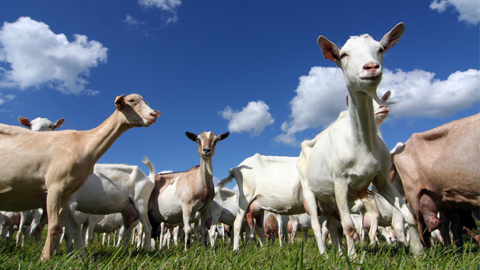Effect of Heat Stress on Dairy Goats

Author: iStockphoto/SebastianKnight.
With the climatic changes observed throughout the last years, an increase in the frequency and severity of heat waves is expected, which will lead to situations of high temperatures and heat stress. Environmental conditions (temperature, humidity, solar radiation, and wind speed) affect animal thermoregulation and its productivity.
In the current research, Murciano-Granadina dairy goats were used to measure the lactational responses to heat stress. Moreover, the effects of soybean oil and propylene glycol supplementation in the diet were evaluated. Goats were exposed to thermal neutral (TN; 15 to 20°C day-night), or heat stress (HS; day, 12-h at 37°C; night, 12-h at 30°C) in climatic chambers.
Compared to TN goats, HS goats experienced greater rectal temperature, respiratory rate, water intake, and water evaporation by panting and sweating. Feed intake of HS goats decreased by 20 to 30%, but milk yield was only reduced by 3 to 10%. The milk of HS goats contained less fat, protein, and lactose. Moreover, milk from HS goats had unexpected behavior during the curd firming stage of coagulation, which would have a negative impact on cheese making process control operations.
Although HS goats consumed less amount of food, they did not mobilize the body fat reserves, but they degraded their muscles to keep the level of blood glucose. Consequently, dairy goats lost body weight when they were under HS. Nutrient digestibilities were improved under HS conditions, which might partially compensate for the reduced feed intake.
The addition of soybean oil to the diets of goats increased milk fat by 30%, and conjugated linoleic acid (CLA) by 360% in milk. The response to soybean oil showed the same magnitude in TN and HS conditions. On the other hand, supplementation with propylene glycol increased blood glucose and blood insulin, but feed intake and milk fat decreased. Consequently, the use of soybean oil, but not of propylene glycol, is recommended to alleviate the effects heat stress in lactating Murciano-Granadina dairy goats.
Department of Animal and Food Science
References
Salama, A. A. K.; Caja, G., Hamzaoui, S.; Badaoui, B.; Castro-Costa, A., Façanha, D. A. E.; Guilhermino, M. M.; Bozzi, R. Different levels of response to heat stress in dairy goats. Small Ruminant Research. 2014, vol. 121, num. 1, p. 73-79. doi: 10.1016/j.smallrumres.2013.11.021.


